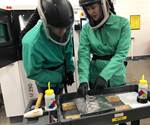Five Training Considerations for Additive Manufacturing
Hands-on courses at the UL AMCC cover factors important for success in AM.
Metal additive manufacturing has many variables—material, heat, part features, etc.—that can affect part quality. Achieving consistently good parts requires a process that regulates these variables as much as possible and an understanding of how they affect the final outcome.
The goal of the UL Additive Manufacturing Competency Center (UL AMCC) is to teach students how to set up a consistent, repeatable additive manufacturing process to achieve quality parts every time. The center, which held its grand opening earlier this year, offers hands-on courses in additive manufacturing for professional engineers, designers and technicians. Students produce their own AM metal parts as part of the coursework. In the process, they learn how to make their sample part successfully, but also how to set up a safe and effective additive manufacturing process.
For manufacturers considering additive manufacturing, the content of that training provides a helpful illustration of what mastering this capability entails. As indicated in this post on UL’s site, success with AM involves all of the following:
- Materials. Each course at UL starts with an in-depth review of metal powders, including safe handling procedures.
- Safety. In addition to how to handle metal powders, students learn how to manage risks across the entire AM process, from pre-production to clean up, including personal protection equipment (PPE) requirements.
- Design for additive manufacturing (DFAM). Students build their own parts during the courses for hands-on experience. While they are welcome to use designs developed by the center, many bring their own. Instructors review the designs for buildability, and help students think through considerations such as support structures that may be necessary.
- Machine setup and operation. Students perform each step in the AM process, including preparing build plates and running the machines.
- Postprocessing. Students separate completed parts from the build plates, remove support structures, and perform any polishing, finishing or other postprocessing required.
Related Content
-
Video: What Is Electron Beam Melting (EBM)?
Electron beam melting is the higher-energy metal 3D printing process offering advantages when it comes to productivity and thermal stresses. Here is an introduction to EBM.
-
3MF File Format for Additive Manufacturing: More Than Geometry
The file format offers a less data-intensive way of recording part geometry, as well as details about build preparation, material, process and more.
-
Implicit Modeling for Additive Manufacturing
Some software tools now use this modeling strategy as opposed to explicit methods of representing geometry. Here’s how it works, and why it matters for additive manufacturing.

.jpg;width=70;height=70;mode=crop)










